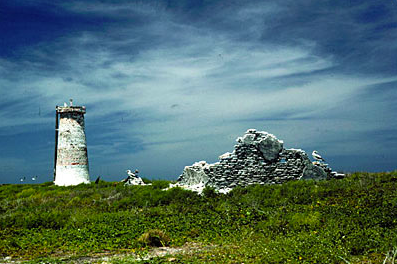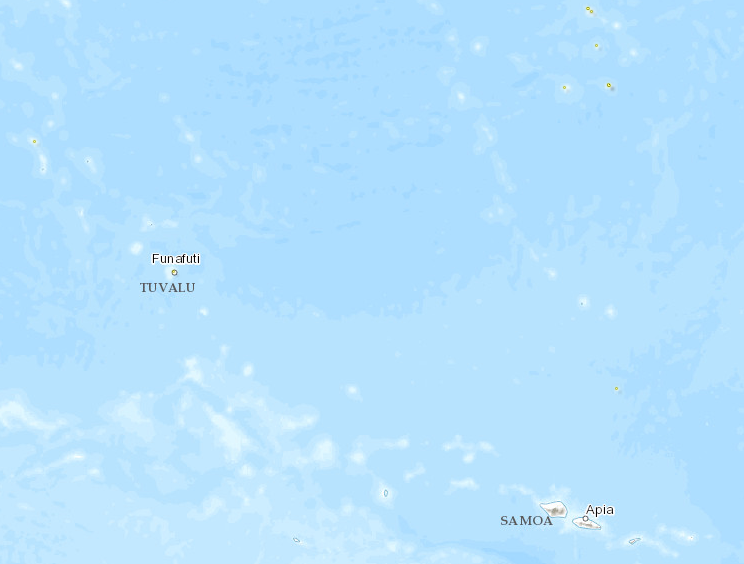Western Polynesian tropical moist forests

Baker Island, USA. (Photograph by U.S. Fish & Wildlife Service)
Introduction Found roughly due north of Samoa and more than 4,000 kilometers (km) from Australia, the atolls (Western Polynesian tropical moist forests) of western Polynesia are extremely remote. Their remoteness, climate, and size have minimized human occupation with the result that some of the islands support incredibly large populations of seabirds. Introduced predators, particularly the Polynesian rat, pose the greatest threat to persisting biodiversity of this region.
Location and General Description
These low atolls and limestone platforms are clustered in three archipelagos with the 8 atolls in the Phoenix Islands ranging from 2 to 5 °S latitude and 171 to 175 °W longitude, the 4 in Tokelau ranging from 8 to 12 °S latitude and 170 to 173 &dg;W longitude, and the 9 in Tuvalu ranging from 6 to 9 °S latitude and 176 to 180 °E longitude. Howland and Baker Islands are isolated. All were formed as coraline limestone accumulated atop subsiding volcanoes over a period of millions of years. Subsequent development of lagoons and dunes has occurred during sea level changes during the Holocene. The climate here is tropical, but rainfall differs dramatically. Howland Island, Baker Island, and most of the Phoenix Islands receive less than 1,000 millimeters (mm) of rain annually with a dry period from March through June. In addition, they are frequently exposed to long droughts during Niño] periods and extremely high rainfalls from cyclones. The atolls of Tokelau and Tuvalu receive annual rainfall of between 1,500 to 3,500 mm, and their rainfall is also more consistent within and between years.
In accordance with patterns of rainfall, the vegetation on wetter islands supports moist forest in protected areas as well as shrubby and herbaceous communities in salt-exposed and rocky areas. Moist forest is dominated by single or mixed species stands of Pisonia grandis up to 25 meters (m) high, Cordia subcordata, or Heliotrope (Tournefortia argentea) with areas of Scaevola taccada and Morinda citrifolia scrub, usually near forest edges. Other common tree species include Calophyllum inophyllum, Pandanus tectorius, Hernandia nymphaeifolia, Ficus tinctoria, Guettarda speciosa, the shrubs Suriana maritime, and Pemphis acidula, the fern Asplenium nidus, and the vine Ipomoea tuba. The drier islands support predominantly herbaceous vegetation. Herbaceous vegetation includes sparse grassland (Lepturus repens) mixed with patches of Portulaca spp., Sida fallax, Sesuvium portulacastrum, Eragrostis whitneyi and some scattered shrubs of C. subcordata, Abutilon asiaticum, Suriana maritime, Pemphis acidula, and Tribulus cistoides.
Biodiversity Features
There are few endemic plants or animals in Western Polynesia, and communities are dominated by species found throughout the Pacific. The reptile and mammal fauna is depauperate, cosmopolitan, and dominated by introduced species. There are no forest passerines and the Pacific pigeon (Ducula pacifica) and migratory long-tailed cuckoo (Eudynamis taitensis) are the only forest birds present anywhere in the islands although banded rails (Rallus philippensis) have recently colonized Nuilakita, Tuvalu from Fiji. The Tokelau Islands support 38 indigenous plants, at least 150 insect species, and 10 land crab species that are present throughout forests.
The Phoenix Islands are unique in the vast numbers of seabirds they support. McKean Island has the world’s largest nesting population of lesser frigatebird (Fregata ariel) with up to 85,000 birds. There are at least 16 other species of seabirds present with more than 1 million total birds in the islands. These islands have also been uninhabited for most of their history so plant communities are intact and few introduced species except Polynesian rats (Rattus exulans) are present. Baker and Howard Islands also support large populations of seabirds.
Current Status
Mining for phosphate occurred on Howland, Baker, McKean, Enderbury, Phoenix, and Sydney Islands during the last century, and disturbance and sparse settlement has occurred on others of the Phoenix Islands. However, all are now uninhabited, have relatively intact vegetation, and support huge numbers of breeding seabirds. The Phoenix Islands have been declared wildlife sanctuaries protected under Kiribati law, but are not patrolled. In addition, Howland and Baker Islands have been part of a wildlife refuge since 1974, and cats have been eradicated from both. The original vegetation on most of the Tuvalu and Tokelau Islands has been replaced by coconut plantation (Cocos nucifera) although in some places this has been abandoned and scrubby forest is present.
Types and Severity of Threats
Introduced mammalian predators pose the greatest threat to remaining ecosystems in Western Polynesia. Polynesian rats are found in the Tokelau Islands and these probably contribute to the relatively low density (1 per 10 m2) of land crabs. Introduced cats and rats pose the greatest threats to nesting seabirds, consuming both adults and young. Where pigs are present, they also have a substantial impact. The greatest future threat is that the low atolls and islands in this area will disappear beneath a rising warmer ocean in this century. Even if islands do not disappear, a slight rise in water level, along with rapidly growing human populations, will reduce the size of the freshwater supply and agricultural lands possibly resulting in a shift in population to areas and atolls that currently support natural vegetation and fauna.
Justification of Ecoregion Delineation
This ecoregion consists of Tuvalu, Tokelau, Kiribati (Phoenix Islands), and Howland and Baker Islands. Van Balgooy groups the low coral islands of the Tuvalu and Kiribati with the Marshalls, Gilberts, and Line Islands based on floristic affinities. Mueller-Dumbois and Fosberg treats Tuvalu, Tokelau, the Northern Cooks, and the Southern Line islands as a unit based on vegetation and climate (moist-zone atolls). This last group are climatically moist low coral islands located in the southeast trade belt. Kiribati, and Howland and Baker Islands, on the other hand, are located in the Equatorial Dry Zone and are treated as a unit (Pacific Equitorial Sporades) with the Southern Line Islands by Mueller-Dumbois and Fosberg. All of these islands are depauperate of native landbirds; Kiribati and Tuvalu share Pacific pigeon (Ducula pacifica) while the Line Islands do not (but contain 2 restricted-range bird species). The Northern Cooks and Southern Line Islands have been split off from the larger groups and joined with the Northern Line Islands to form the Central Polynesia ecoregion, leaving the remaining West-Central Polynesian islands to form the Western Polynesian ecoregion. This arrangement is under review.
Additional information on this ecoregion
- For a shorter summary of this entry, see the WWF WildWorld profile of this ecoregion.
- To see the species that live in this ecoregion, including images and threat levels, see the WWF Wildfinder description of this ecoregion.
- World Wildlife Fund Homepage
Further Reading
- Dahl, A.L. 1980. Regional ecosystems survey of the South Pacific area. South Pacific Commission, Noumea, New Caledonia.
- Garnett, M.C. 1983. A management plan for nature conservation in the Line and Phoenix Islands. Unpublished report, Government of the Republic of Kiribati.
- McQuarrie, P. 1991. The Banded Rail: a new bird record for Tuvalu. South Pacific Journal of Natural Science, 11:36-39.
- Mueller-Dombois, D., and F.R. Fosberg. 1998. Vegetation of the Tropical Pacific Islands. Springer Press, New York. ISBN: 038798285X
- Parham, B.E.V. 1970. The vegetation of the Tokelau Islands with special reference to the plants of Nukunonu Atoll. New Zealand Journal of Botany, 9:576-609.
- Perry, R. 1980. Wildlife conservation in the Line Islands, Republic of Kiribati (formerly Gilbert Islands). Environmental Conservation, 7:311-318.
- Rodgers, K.A. 1991. A brief history of Tuvalu’s natural history. South Pacific Journal of Natural Science, 11:1-14.
- Roy, P., and J. Connell. 1997. Climatic change and the future of atoll states. Journal of Coastal Research, 7:1057-1075.
- Schofield, J.C. 1977. Late Holocene sea-level, Gilbert and Ellice Islands, west central Pacific Ocean. New Zealand Journal of Geology and Geophysics, 20:503-529.
- Van Balgooy, P.H. Hovenkamp, and P.C. Van Welzen. 1996. Phytogeography of the Pacific – floristic and historical distribution patterns in plants. Pages 191-213 in Keast, A. and S.E. Miller, editors. The origin and evolution of Pacific island biotas, New Guinea to Eastern Polynesia: Patterns and processes. SPB Academic Publishing, Amsterdam. ISBN: 905103136X
- Wodzicki, K., and M. Laird. 1970. Birds and bird lore in the Tokelau Islands. Notornis, 17:247-276.
- Yaldwyn, J.C. and K. Wodzicki. 1979. Systematics and ecology of the land crabs (Decapoda: Coenobitidae, Grapsidae, and Gecarcinidae) of the Tokelau Islands, central Pacific. Atoll Research Bulletin, 235:1-53.
| Disclaimer: This article is taken wholly from, or contains information that was originally published by, the World Wildlife Fund. Topic editors and authors for the Encyclopedia of Earth may have edited its content or added new information. The use of information from the World Wildlife Fund should not be construed as support for or endorsement by that organization for any new information added by EoE personnel, or for any editing of the original content. |
